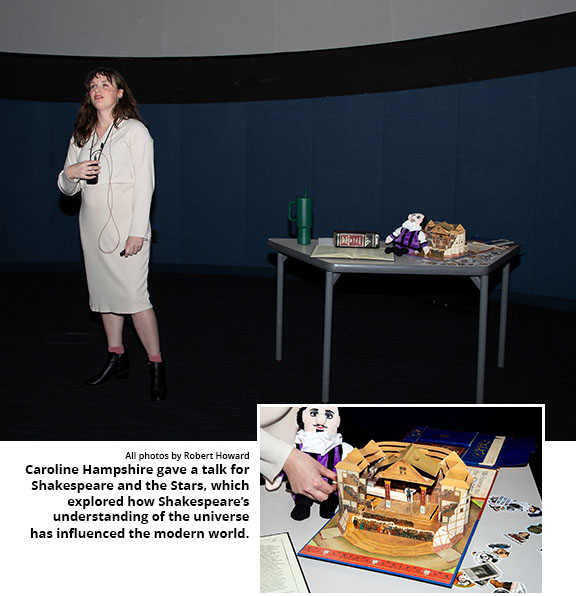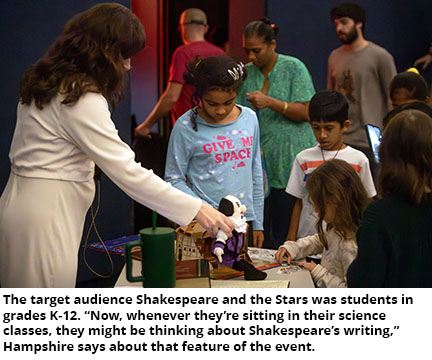Festival of the Creative Arts: Shakespeare and the Stars
By Emma Jowers
The Florida State University Office of Research’s Festival of the Creative Arts (FoCA), in partnership with the Challenger Learning Center, collaborated to present Shakespeare and the Stars.
The Feb. 8 presentation was a fascinating way to engage students in the literary work of Shakespeare and the wonder of astronomical concepts. The event was one of 12 during the month-long festival, which ended Feb. 23.
English-Literature, Media, and Culture doctoral candidate Caroline Hampshire participated in Shakespeare and the Stars, which started with her talk in the center’s planetarium. The discussion explored how Shakespeare’s understanding of the universe has heavily influenced our modern world, from literature to architecture such as Shakespeare’s Globe.
“Being able to do this talk was fantastic, especially in the planetarium, which is itself a unique kind of performance space, and like Shakespeare’s theater, brings people together to look at performance and better understand our world and humanity,” Hampshire says.
Having the Challenger Learning Center as the venue allowed the significance of Shakespeare’s classics to be partnered with the curiosity of scientific discovery. The planetarium itself proved to be a main attraction during the four hours of festivities.
“I love being in our planetarium,” says Alan Hanstein, the executive director at the Challenger Learning Center. “Then, being able to show the night sky to the audience after Caroline finished her talk, gave an idea of what it would have looked like even in Shakespeare’s time.
“I loved the juxtaposition of Shakespeare and science and kind of what was happening around his lifetime, as far as exploration of the heavens.”
A key feature of Shakespeare and the Stars was the target audience: students in grades K-12. Teaching younger students on interdisciplinary collaboration and highlighting its importance throughout education was a focus throughout the day.
 “I think it is really important for kids K-12 to be able to learn across disciplines,” Hampshire says. “Now, whenever they’re sitting in their science classes, they might be thinking about Shakespeare’s writing.”
“I think it is really important for kids K-12 to be able to learn across disciplines,” Hampshire says. “Now, whenever they’re sitting in their science classes, they might be thinking about Shakespeare’s writing.”
In addition to Hampshire’s segment of the program, many activities took place on the bottom floor of the center, including watching the FSU Flying High Circus perform and drawing your own constellations and solar systems. The interactive nature allowed attendees to see natural connections between arts and sciences. Students and educators alike were encouraged to combine fact and creativity, leading to new discoveries on both fronts.
In addition to the English department, other FSU departments and colleges joined to help put on the event.
“We have so many different faculty here—we have art education, we have interior architecture and design over there, we have music education over there,” Professor of Organ and Coordinator of Sacred Music and FoCA Director Iain Quinn said, pointing to sections of the center’s floor. “Various areas of art all within a matter of feet of each other.”
The festival exemplifies how interdisciplinary work leads to the furthering of knowledge and progress and encourages diversity in education, Quinn added.
The environment for Shakespeare and the Stars not only highlighted Shakespeare’s influence in society but also helped clearly display, scientifically, what he was writing about philosophically, giving attendees the opportunity to learn literature and science in an immersive and tangible way. Hampshire’s involvement in one of the highlights of this year’s festival also helps educate potential future generations of FSU students on the importance of literature.
Emma Jowers is an English major on the editing, writing, and media track, with a minor in communications.
Follow the English department on Instagram; on Facebook; and on X.

